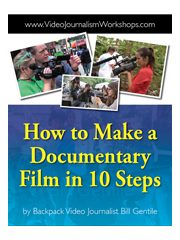NINDIRI, Nicaragua 13 December 2015 — After my Backpack Video Journalism Workshop, I stayed on an additional to enjoy and to reminisce. It was worth it.
(Photo by Bill Gentile)
NINDIRI, Nicaragua 13 December 2015 — After my Backpack Video Journalism Workshop, I stayed on an additional to enjoy and to reminisce. It was worth it.
(Photo by Bill Gentile)
Remember to sign up for our free Essential Tips and Tools pdf booklet over on the right, and give us a like on Facebook.
MANAGUA, Nicaragua, 12 December 2015 — This is the newest generation of Nicaragua’s Backpack Video Journalists. They’ve completed my four-day workshop, titled, “Training the Trainers.” They are ready, not only to practice our craft, but also to pass it on the the next generation.
Good luck and stay safe.
— Bill Gentile
Remember to sign up for our free Essential Tips and Tools pdf booklet over on the right, and give us a like on Facebook.
MANAGUA, Nicaragua, 12 December 2015 — On the last day of our Backpack Video Journalism Workshop, we lost power because of maintenance work on the electrical system at the venue where the event was held. Despite numerous challenges during the four-day event, every one of the participants managed to produce a respectable video. I’m so very proud of them all. In this photo, participants screen their final projects on their laptops — before the computers run out of power.
(Photo by Bill Gentile)
Remember to sign up for our free Essential Tips and Tools pdf booklet over on the right, and give us a like on Facebook.
MANAGUA, Nicaragua, 11 December 2015 — U.S. Ambassador to Nicaragua Laura F. Dogu (in blue jacket) visits my Backpack Video Journalism Workshop in the Nicaraguan capital. Titled, “Training the Trainers,” the four-day event was sponsored and funded by the U.S. Embassy.
Remember to sign up for our free Essential Tips and Tools pdf booklet over on the right, and give us a like on Facebook.
ACCRA, Ghana, 28 November 20105 — At lunch at SAA’s house (she’s on the far left) celebrating the end of our Backpack Video Journalism Workshop. Great curry, SAA! SAA is one of 13 journalists who participated in the event. The five-day workshop was hosted by the African Centre for Development Reporting (ACEDEV) and funded by the U.S. Embassy in Accra. It was a terrific opportunity to bring the methodology of “backpack video journalism” to working journalists eager to use video to address the development needs of their country. I am so grateful. In the white dress is Ama Boateng, one of the ACEDEV staffers who helped organize the workshop. She’s also the Al Jazeera correspondent in Ghana. Next to her is Mohammed Shardow, one of the workshop participants. Then there is Manuela, the daughter of workshop participant Kwamee Kwame. And next to me is my very good friend Kumah Drah, who first invited me to his country to conduct the workshop. We are holding one of the gifts so graciously given to me by my African friends and colleagues. Thank you all.
Remember to sign up for our free Essential Tips and Tools pdf booklet over on the right, and give us a like on Facebook.
ACCRA, Ghana, 25 November 2015 — On this, the third day of our five-day Backpack Video Journalism Workshop, I shared my latest video report from the Ecuadorian Amazon. “When the Forest Weeps” examines how Ecuador’s Kichwa Indians struggle as their deep spiritual relationship with the Amazonian rain forest diminishes in a clash with the forces of so-called modernity. It is a story not unlike the clash between the traditional way of life in many areas of Africa and the forces of so-called modernity impacting lives across the continent.
To see the film, go to my blog at www.billgentile.com.
(Photo by Bill Gentile)
Remember to sign up for our free Essential Tips and Tools pdf booklet over on the right, and give us a like on Facebook.
KABUL, Afghanistan, 7 January 2014 — This is a brief clip I shot in a refugee camp in Kabul. According to a camp spokeswoman, the camp houses about 1,500 people from across Afghanistan who have fled the war. She said some of the refugees have been here for as long as 12 years. No running water. Open sewers. No electricity. Some of the kids don’t have shoes.
In a May 2012 report, the Washington, DC-based Center for Strategic and International Studies (CSIS) estimated that if government figures on Afghanistan “for FY2001-FY2013…are totaled for all direct spending on the war, they reach $641.7 billion.”
That’s right, $641.7 billion, with a “B.”
The CSIS report goes on: “This is an incredible amount of money to have spent with so few controls, so few plans, so little auditing, and almost no credible measures of effectiveness.”
Indeed, the spokeswoman at the refugee camp asked what happens to all the money donated by foreign countries, especially the United States. Why are thousands of people living in conditions like the ones in this video?
I didn’t have any answers. Click HERE to see the clip.
#documentaries
Remember to sign up for our free Essential Tips and Tools pdf booklet over on the right, and give us a like on Facebook.
KABUL, Afghanistan, 5 January 2014 — Two boys eat a lunch of leftover rice in a refugee camp on the edge of Kabul. About 1,500 people live in this squalid complex of tents and dirt homes. Especially in winter, as the temperature at night hovers below zero, life here is tenuous, particularly for children. The New York Times carried a front-page story recently about malnutrition running rampant among Afghan children — despite billions of dollars in aid during the last 10 years.
Working in these camps is a challenge. In addition to the grinding misery that is harder to accept each time you see it, navigating through masses of people in need becomes more difficult each time you do it. You do so by telling yourself that your work means something. You say that perhaps it will draw attention to their plight. And then you hope that it does.
Remember to sign up for our free Essential Tips and Tools pdf booklet over on the right, and give us a like on Facebook.
WASHINGTON, DC, 23 December 2013 — One of the most interesting films made during our recent Backpack Video Journalism Workshop in Montevideo, Uruguay, was done by Juan Marra about a young man who paints the sidewalks near his home in an effort to brighten up the neighborhood.
This is just another example of how stories present themselves to those of us who open our eyes, and perhaps our hearts, in order to see and to feel them. You don’t have to go to Syria to find a good story. There’s probably one, on your own block, waiting for you to tell it.
The five-day workshop was organized by Valentina Quagliotti, an exchange student at American University in 2010. Valentina is the founder of Ikusi, a non-profit dedicated to making positive social change with video. My trip to Uruguay was funded by the U.S. Embassy in Montevideo.
Remember to sign up for our free Essential Tips and Tools pdf booklet over on the right, and give us a like on Facebook.


List price: $395.00
Now for a limited time only $295.00
Copyright 2012, Bill Gentile. All rights reserved. Website by Nick Ray, Design by Bruce Jones.